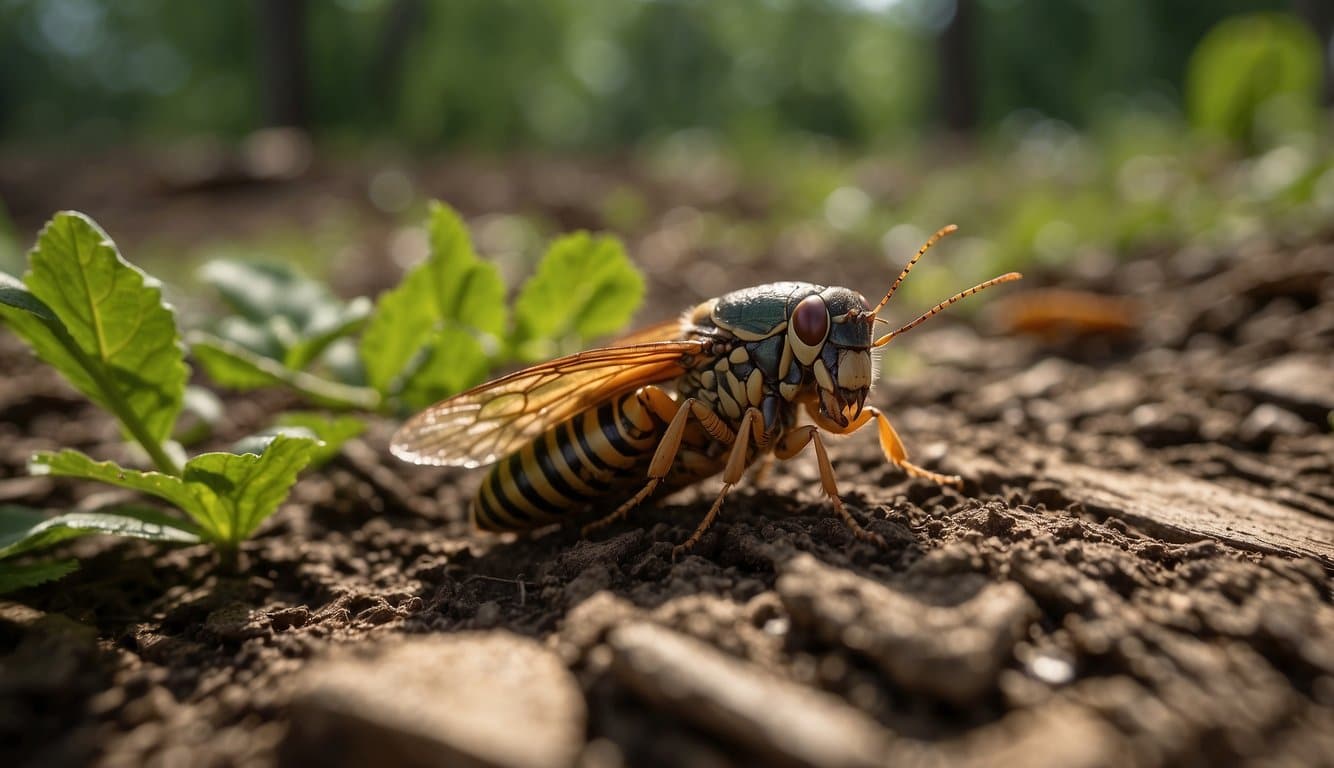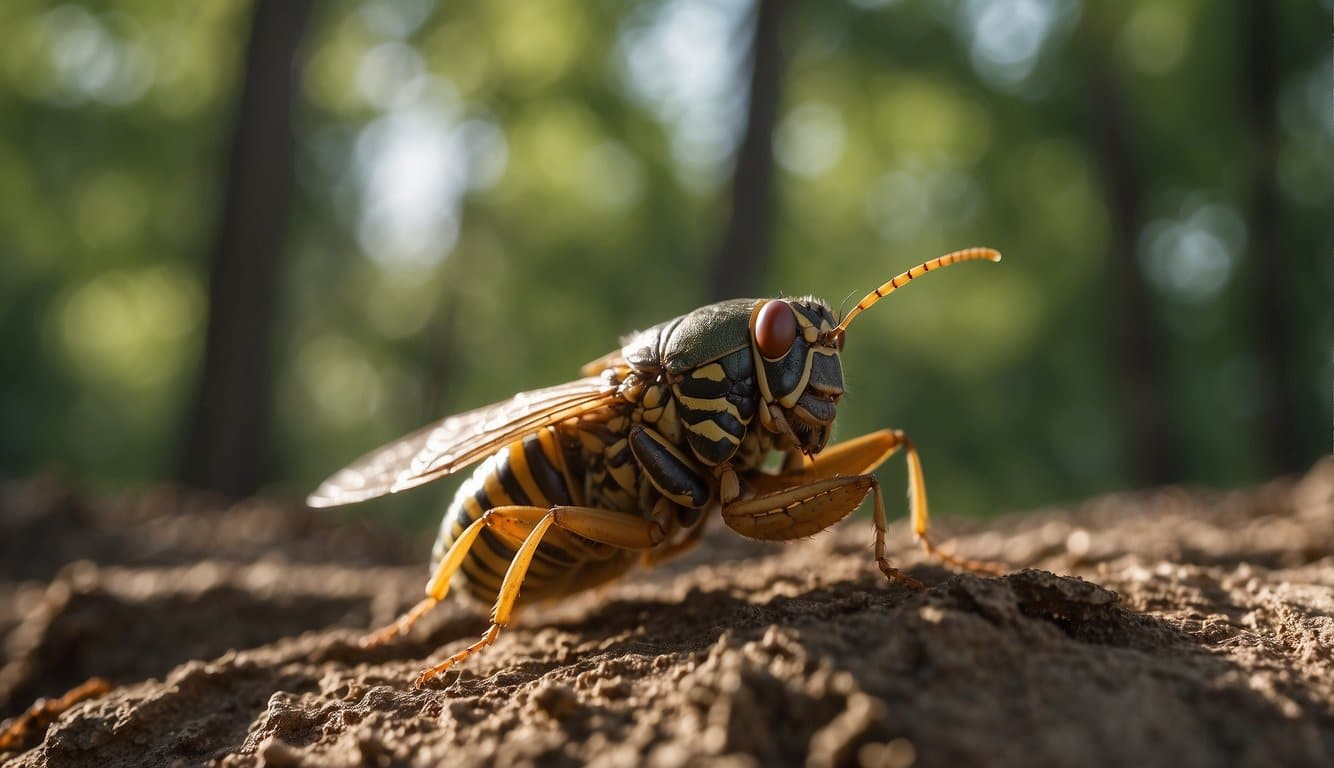Cicada Emergence in Wisconsin 2024
Get ready for a buzzing summer! The 17-year cicadas, commonly known as Brood XIII, are slated to surface in Wisconsin this 2024.
- Timing: You can expect these noisy neighbors to start popping up in late May. They’re tuned into the soil temperature and make their grand entrance when it hits the sweet spot above 64.5°F.
Fun Fact: The last time these cicadas were seen was in 2007 – it’s a rare event!
- Location: Look out for them in parts of Wisconsin where they have historically emerged. Keep an ear out for their symphony if you’re in historically active areas.
- What to Expect:
- Sight: The view of millions of cicadas might be overwhelming.
- Sound: Their distinctive chirps will fill the air as the males “sing” to attract a mate.
- Duration: This insect concert isn’t a one-hit-wonder; it can last up to four to six weeks.
- Why Care?: Beyond their fascinating life cycle, cicadas benefit the ecosystem. They aerate the soil, and once they pass, they provide nutrients as they decompose.
Embrace this natural spectacle with curiosity and a bit of patience.
Enjoy your front-row seat to one of nature’s most interesting cycles! If you want a deep dive into cicada dynamics, check out what UW-Madison experts have shared.
Get your cameras ready, and maybe some earplugs, for this rare cicada summer in Wisconsin!
Cicada Species in the Midwest
Get ready to mark your calendars and prep your ears, because the Midwest’s cicada scene is buzzing with anticipation. Two distinct types of cicadas share the stage in this region: the unique periodical cicadas, known for their impressively synchronized life cycles, and the more familiar annual cicadas that grace us with their presence every year.
Periodical Cicadas
- Emergence: Once every 17 years, a phenomenon unfolds as brood XIII cicadas prepare to surface in Wisconsin, inching towards a remarkable natural event you won’t want to miss in 2024.
- Broods: Multiple broods exist, each with staggering numbers that create a natural symphony like no other.
In areas like Wisconsin, keep your eyes peeled because 17-year cicadas are set to turn the quiet woods into a vibrant hub of activity.
Annual Cicadas
- Frequency: Unlike their periodical cousins, these cicadas make an appearance every summer, becoming a familiar and anticipated part of the season.
- Species: There are several species you might encounter, each with its unique song that fills the summer evenings.
Whether you’re in Illinois, Iowa, or your very own backyard, annual cicadas are a staple of the summertime ambiance, providing a soundtrack to your outdoor adventures.
Cicada Lifecycle and Behavior
Get ready to mark your calendars, because Wisconsin is about to witness a remarkable natural event—the emergence of periodical cicadas, specifically Brood XIII, after a 17-year underground stint. Here’s a sneak peek into the remarkable lifecycle and behavior of these buzzing harbingers of summer:
- Nymphs (Below Ground): After cicada eggs hatch, the ant-sized nymphs drop to the ground and burrow beneath the soil. Imagine spending 17 years underground—talk about ultimate hide and seek champions!
During their subterranean phase, they undergo five instar stages, nourishing themselves by sipping on sap from tree roots.
- Emergence (Above Ground): When the soil temperature 8 inches deep hits just over 64°F, the cicada nymphs surface in a synchronized debut, typically in late May.
You’ll notice their empty shells adorning trees—an eerie, yet fascinating sight.
- Transformation: Once above ground, nymphs shed their exoskeletons for the last time, transforming into adults with a distinctive black and orange coloration and those unmistakable transparent wings.
Adult Activities:
- Mating Call: Males perform a chorus of loud calls to attract females—nature’s very own rock concert.
- Reproduction: After mating, females slice into twigs with their ovipositor and lay eggs.
- The Cycle Continues: Upon hatching, this new generation begins the cycle anew, promising another grand emergence in years to come.
Check out some cool facts about Wisconsin’s periodical cicadas right at your fingertips: Wisconsin’s periodical cicadas.
Impact on Ecosystem and Human Activities
Get ready to buzz with excitement because Wisconsin’s air is about to become a symphony of cicada song. Brood XIII is making its grand appearance in 2024, and here’s what you can expect for the local ecosystem and your day-to-day activities:
- For the Green Thumbs
- Your gardens will experience a natural pruning, thanks to cicada nymphs that feed on roots before emerging. Don’t worry—it usually doesn’t cause lasting damage.
- In a quirky twist of nature, trees may actually benefit; cicadas aerate the soil as they emerge!
- Wildlife Windfalls
- Local critters are throwing a feast! From birds to small mammals, everyone’s dining on cicadas.
- This buffet means you’re likely to see an increase in predatory species. Hello, owl and hawk sightings!
- Human Hubbub
- Brace yourself for some noise. Your earplugs might become your best friend.
- Outdoor events? Cicadas could be uninvited guests swooping in.
- Sensational Science
- You’ve got a front-row seat to a natural wonder. Every 17 years, like clockwork! Isn’t that something?
Predator and Prey Dynamics
When you step into the lush landscapes of Wisconsin this summer, you’ll witness an extraordinary event: the emergence of 17-year cicadas. These little critters aren’t just a marvel for your ears and eyes—they’re a feast for local wildlife. Here’s how they shake things up in the food chain:
- Birds: Get your binoculars ready! Birds treat cicadas like an all-you-can-eat buffet. They’ll be diving and darting, snatching these insects midair or off the trees.
- Small Mammals: Creatures like squirrels and mice will find the cicadas hard to resist. They’ll be munching on these protein-packed insects to their hearts’ content.
Expect to see an increase in predator activity due to the cicada bounty. Here are the dynamics you may observe:
- Spike in Predators: More food means more predators. You’ll likely see larger numbers of birds and small mammals as they capitalize on the abundance of cicadas.
- Prey Relief: Other insects and small creatures might get a temporary respite from predation as cicadas become the primary target.
Not just land-based predators, fish will also benefit from cicadas that find their way into streams and lakes. Watch for splashes as fish leap to grab a crunchy morsel falling from above.
Frequently Asked Questions
Curiosity is peaking as the ground prepares for a grand entrance. Here, you’ll find the skinny on cicadas in Wisconsin for 2024 that leaves no stone—or leaf—unturned.
What’s all the buzz? When do cicadas typically emerge in Wisconsin?
You can expect these noisy neighbors to punch their time cards when soil temperatures hit about 64.5°F at an 8-inch depth. This usually translates into a late May arrival, with some variances for Mother Nature’s whims.
Get your calendars out! Can we expect a cicada serenade in Wisconsin this 2024?
Gear up for a natural symphony this summer, as Brood XIII is on the docket for their 17-year encore in Wisconsin. This 2024 cicada emergence is a performance you won’t want to miss!
Mapping the melody: Where can I find a map of cicada activity in Wisconsin for 2024?
For the cartographically inclined, maps of periodical cicada activity are a treasure, and UW-Madison has the trove you seek. Plot your cicada-sighting escapades or simply be nosy about where they’ll pop up.
The great cicada vacation: How often do these winged wonders visit Wisconsin?
These critters stick to a strict travel schedule, visiting every 17 years like clockwork. Brood XIII last checked in during 2007, meaning their 2024 arrival is right on time.
Looking ahead: Are cicada concerts scheduled for Wisconsin in 2025?
Once the 2024 cacophony concludes, the next big gig isn’t until the 2041 tour. Your anticipation can start building now for future generations to enjoy the song.
Sing us a song, you’re the cicada man: What does Wisconsin’s cicada soundtrack sound like?
This isn’t your average critter chorus. When cicadas take the stage, it’s a full-blown crescendo peaking at 90 decibels. This is comparable to a lawnmower in full throttle.
Prepare for a sonic experience that truly embodies the spirit of summertime in Wisconsin.


